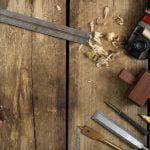Woodworking is a craft that requires skill, precision, and attention to detail. But in addition to honing their woodworking techniques, woodworkers must also consider what they wear during their work. Appropriate attire plays a crucial role in not only ensuring safety but also enhancing efficiency in the woodworking process. In this article, we will delve into the world of woodworking fashion, exploring the importance of protective clothing and providing guidance on what woodworkers should wear for different tasks.
When it comes to woodworking, safety should always be the foremost concern. The right protective gear can make a significant difference in preventing injuries and accidents. Coveralls and work aprons shield the body from sawdust and flying debris while safety goggles and glasses safeguard the eyes from potential hazards. Gloves protect hands from cuts, splinters, and chemicals, while steel-toed boots ensure foot safety amidst heavy machinery and tools.
But woodworking fashion goes beyond just safety gear. Different tasks require different attire for optimal comfort and functionality. The choice of t-shirts or long-sleeve shirts depends on factors such as fabric selection and fit to ensure both ease of movement and protection.
Similarly, pants and shorts need to be chosen based on material and style for flexibility while still providing adequate protection. Headgear and hats play a crucial role in shielding the head and hair from wood particles and dust.
Woodworking fashion is not just about practicality; it’s also an avenue for expressing personal style within the craft. From customizing work attire with patches, logos, or patterns to showcasing individuality through color choices and designs – woodworkers have room to incorporate their own taste into their clothing choices.
In this article, we will explore all aspects of woodworking fashion – from essential protective gear to appropriate dress codes for different tasks. We will also dive into climate considerations for working in hot or cold weather conditions, as well as tips for finding the perfect fit for optimal comfort.
Lastly, we will discuss how dressing professionally can elevate a woodworker’s image and potentially open doors for career advancement in the woodworking industry. Stay tuned for an in-depth exploration of all things woodworking fashion and how it can enhance both safety and success in this craft.
Safety First
When it comes to woodworking, safety should always be the top priority. To ensure a safe working environment, woodworkers must invest in appropriate protective gear. This section will highlight the must-have protective gear that every woodworker should have.
Coveralls and work aprons are essential pieces of protective clothing for woodworkers. These garments shield the body from sawdust and flying debris that can cause harm or discomfort. Coveralls, made from durable materials such as denim or canvas, provide full-body protection and prevent sawdust from entering clothes. Work aprons, on the other hand, offer protection to a specific area like the torso or legs and allow for greater ease of movement.
Protecting one’s eyes is crucial in woodworking due to potential hazards from flying particles. Safety goggles and glasses are necessary to safeguard against eye injuries caused by dust, splinters, or chemicals present in the workshop. It is important to choose goggles or glasses with shatterproof lenses and a snug fit to prevent any debris from getting behind them.
Woodworking often involves handling rough materials that can lead to cuts or splinters on hands. Therefore, gloves are an indispensable part of a woodworker’s protective gear. Gloves offer not only physical protection but also protect against contact with chemicals commonly used in woodworking tasks. It is recommended to choose gloves that fit well and are made of sturdy materials such as leather or synthetic fibers.
Lastly, woodworkers should prioritize foot safety amidst heavy machinery and tools by wearing steel-toed boots. These boots provide protection against falling objects and accidental tool drops that could potentially cause severe injuries to the feet. Steel-toed boots with non-slip soles are ideal for traction on various surfaces encountered in a woodworking environment.
By investing in these must-have pieces of protective gear – coveralls/work aprons, safety goggles/glasses, gloves, and steel-toed boots – woodworkers can significantly reduce the risk of injuries and create a safer working environment. Remember, safety should always come first in woodworking.
Dress Code Breakdown
When it comes to woodworking, having the right attire for different tasks is crucial. Wearing the appropriate clothing not only ensures comfort and functionality but also enhances safety and efficiency. In this section, we will break down the dress code for different woodworking tasks, focusing on the key items of clothing to consider.
T-shirts and long-sleeve shirts
Choosing the right fabric and fit for your t-shirts and long-sleeve shirts is important in woodworking. Opt for durable materials like cotton or polyester blends that can withstand wear and tear. It’s also essential to select a comfortable fit that allows freedom of movement without being too loose or too tight. Consider wearing long-sleeve shirts when working with more abrasive materials or when additional protection is needed.
Pants and shorts
When it comes to pants and shorts for woodworking, choosing the ideal material and style is vital. Look for pants made of thick and sturdy fabric such as denim or canvas. These materials provide better protection against cuts, splinters, and other potential hazards you may encounter in woodworking. Ensure that your pants allow for flexibility at the knees and hips to facilitate easy movement.
Headgear and hats
Protecting your head and hair from wood particles, dust, and other debris is essential during woodworking tasks. Consider wearing a cap or hat to keep your hair under control while also shielding your scalp from falling objects or flying debris. Additionally, using headgear such as bandanas, beanies, or skull caps can help absorb sweat throughout the day.
By carefully considering these aspects of dressing appropriately for different woodworking tasks, woodworkers can enhance both their safety and overall experience in the workshop. Having comfortable clothing that provides adequate protection enables greater focus on creating quality woodwork while minimizing distractions from discomfort or safety concerns.
Functional Fashion
In addition to wearing the appropriate clothing, woodworkers can enhance their productivity and ensure their safety by investing in functional accessories and extras. These accessories not only provide practical benefits but also contribute to the overall professionalism and efficiency of woodworking tasks.
One essential accessory for woodworkers is a tool belt or apron. These items allow woodworkers to conveniently organize and carry essential equipment such as measuring tools, markers, screwdrivers, and nails. By having these tools easily accessible, woodworkers can save time and increase their efficiency in completing their projects. Furthermore, tool belts and aprons prevent the loss or misplacement of tools, reducing the risk of accidents caused by searching for misplaced equipment.
To minimize strain and discomfort during extended work periods, woodworkers can consider using knee pads and elbow pads. These protective gear items provide cushioning and support, reducing pressure on joints when kneeling or leaning against hard surfaces. By minimizing discomfort, woodworkers can concentrate better on their tasks without distractions or pain.
Another important accessory that woodworkers should consider is a respirator or mask. These devices filter airborne particles generated during woodworking processes, preventing inhalation of harmful substances such as sawdust or chemicals. Breathing in these particles can lead to respiratory issues and allergies. Therefore, using quality respirators or masks helps protect the respiratory system from potential health hazards.
These functional accessories not only contribute to comfort and safety but also help woodworkers portray professionalism in their craft. By investing in these extras, woodworkers demonstrate a commitment to their work by prioritizing safety measures, increasing efficiency through organization, and ensuring personal well-being during extended work periods.
| Accessory | Main Purpose |
|---|---|
| Tool Belt/Apron | Conveniently organize and carry essential tools |
| Knee Pads/Elbow Pads | Minimize strain and discomfort during extended work periods |
| Respirator/Mask | Filter airborne particles to prevent inhalation of harmful substances |
Climate Considerations
Woodworking is a craft that requires focus, precision, and attention to detail. To perform at their best, woodworkers need to be dressed appropriately for the task at hand, taking into account the climate they are working in. Whether it’s sweltering heat or freezing cold, dressing for woodworking in different weather conditions is crucial for comfort and safety.
When working in hot weather, lightweight and breathable clothing options are key. Opting for moisture-wicking fabrics such as cotton or linen can help keep you cool by absorbing sweat and allowing it to evaporate quickly. Loose-fitting t-shirts or short-sleeve shirts are ideal for allowing air to circulate around your body. Additionally, choosing lighter colors like white or pastels can reflect sunlight and minimize heat absorption.
On the other hand, woodworking in cold weather requires layering and insulating clothing. Layering allows you to add or remove clothing depending on your body temperature throughout the day. Start with a moisture-wicking base layer made of materials like merino wool or synthetic fabric, which will help regulate your body temperature and keep you dry.
Over this base layer, wear insulating clothing such as fleece jackets or vests to trap heat close to your body. Finally, top it off with a windproof and waterproof outer shell to protect yourself from the elements.
It is also important to be prepared for temperature fluctuations that may occur within the workshop itself. Workshops can sometimes have inconsistent heating or cooling systems, creating uncomfortable working conditions. In these cases, consider using zipped jackets or removable layers that allow you to easily adjust your clothing throughout the day.
By dressing appropriately for different weather conditions during woodworking tasks, woodworkers can ensure their own comfort and safety while maximizing productivity. While style is important when considering attire for woodworking tasks, ensuring practicality and functionality should always remain a priority.
- Lightweight and breathable clothing options are recommended when woodworking in hot weather.
- Moisture-wicking fabrics like cotton or linen can help keep the body cool by absorbing sweat.
- Loose-fitting t-shirts or short-sleeve shirts allow air to circulate, keeping you comfortable in hotter temperatures.
- Layering and insulating clothing is key when woodworking in cold weather.
- Start with a moisture-wicking base layer, such as merino wool or synthetic fabric, to regulate body temperature and keep dry.
- Add insulating layers like fleece jackets or vests to trap heat close to the body.
- Top it off with a windproof and waterproof outer shell for protection against the elements.
- Be prepared for temperature fluctuations within the workshop itself by using zipped jackets or removable layers that allow easy adjustment of clothing throughout the day.
Crafting Style
Woodworking attire doesn’t have to be all about safety and functionality. It can also be an opportunity for woodworkers to showcase their personal style and creativity. Incorporating personal fashion into woodworking attire allows woodworkers to express their individuality, add a touch of personality to their work outfits, and create a unique identity in the woodworking community.
Customizing and Personalizing Work Attire
One way woodworkers can incorporate personal fashion into their work attire is by customizing and personalizing their clothing. Adding patches, logos, or patterns to clothing items such as coveralls, aprons, or even t-shirts can make them more visually appealing and reflective of the woodworker’s personality.
For example, a woodworker who specializes in creating rustic furniture may choose to add a patch with a tree design to their apron or wear shirts with nature-inspired patterns. These small style choices can act as conversation starters, allowing woodworkers to proudly display their unique craft and design preferences.
Showcasing Individuality through Colors and Designs
Incorporating personal fashion into woodworking attire also means experimenting with colors and designs that reflect one’s individuality. While safety gear like goggles and gloves typically come in standard colors for visibility purposes, there is flexibility when it comes to choosing shirts, pants, or headgear.
Woodworkers can opt for colors that they feel most confident in or that complement their skin tone. Additionally, choosing clothing items with interesting designs or patterns can add a fun element to woodworking attire while still maintaining functionality.
Whether it’s showcasing favorite hobbies or incorporating elements of nature into clothing choices, embracing personal style gives woodworkers an opportunity to stand out from the crowd while still prioritizing safety and comfort.
Finding the Perfect Fit
Woodworking requires precision and meticulousness, and that applies not only to the work being done but also to the attire being worn. Proper sizing and tailoring are crucial aspects of woodworkers’ outfits to ensure safety, comfort, and ease of movement. Ill-fitting clothing can pose hazards in the woodworking environment, leading to accidents or discomfort that hampers productivity. This section explores the importance of finding the perfect fit in woodworkers’ clothing and provides tips for measurements and adjustments.
When it comes to woodworking attire, a one-size-fits-all approach simply does not work. Ill-fitting clothing can get caught in machinery or tools, leading to serious injuries. Additionally, loose garments may restrict movement or hinder dexterity when handling delicate pieces or performing intricate woodworking tasks. On the other hand, clothes that are too tight can restrict blood circulation and cause discomfort during extended periods of work.
To find the perfect fit for your woodworking clothing, it is essential to take accurate measurements. Start by measuring your chest, waist, hips, inseam, and arm length. Use a tape measure for precise measurements and refer to size charts provided by manufacturers for guidance. Remember that different brands may have variations in sizing standards, so it is important to consider their specific size charts.
In addition to measuring yourself accurately, it is also important to understand how certain adjustments can optimize movement and flexibility while working in the workshop. For example, pants with a slightly higher rise can provide better coverage when bending or reaching down. Adding gussets to shirts or jackets can give more room for arm movement without compromising the overall fit.
| Tip | Description |
|---|---|
| Measurements | Accurately measure your chest, waist, hips, inseam, and arm length. |
| Size Charts | Refer to size charts provided by manufacturers for guidance. |
| Consider Brand Differences | Account for variations in sizing standards among different brands. |
| Pants Rise | Select pants with a slightly higher rise for better coverage during movements. |
| Add Gussets | Increase arm movement by adding gussets to shirts or jackets. |
Finding the perfect fit in woodworking attire goes beyond just safety and comfort. It also contributes to a professional appearance that showcases your dedication to your craft. Well-fitted clothing can convey competence, attention to detail, and a level of professionalism that garners respect from clients and peers alike. By investing time in finding clothing that fits properly, woodworkers demonstrate their commitment to quality workmanship in every aspect of their trade.
Dressing for Success
Woodworking is not only a skillful craft but can also be a lucrative career. When it comes to showcasing professionalism and skill in the woodworking industry, dressing appropriately plays an important role. Whether meeting with clients or participating in woodworking showcases, how you present yourself can make a lasting impression. Here are some tips for dressing for success in woodworking:
- Dressing for Client Meetings: When meeting with clients, it’s essential to create a positive and professional image. Opt for clean and well-fitted clothing that is appropriate for the setting and the client’s expectations. A collared shirt paired with khakis or dress pants can lend an air of professionalism, while still allowing freedom of movement.
- Woodworking Showcases: Participating in woodworking showcases provides an opportunity to demonstrate your skills and attract potential customers. Dressing appropriately for these events is crucial as it reflects your expertise and attention to detail. Consider wearing your best work attire, such as a button-down shirt and jeans or tailored work pants, along with steel-toed boots for safety.
- Attention to Grooming: In addition to clothing choices, personal grooming is equally important in presenting yourself professionally. Keep your hair neat and tidy, maintain clean hands and nails, and remember to wear any necessary safety gear like goggles or respirators when working on projects or giving demonstrations.
Remember that dressing professionally not only showcases your skills and expertise but also instills confidence in clients and potential customers. By paying attention to your appearance, you demonstrate that you take your craft seriously, which can open doors for career advancement opportunities.
Conclusion
In conclusion, it is clear that woodworkers should prioritize safety and comfort when it comes to their choice of attire. The importance of appropriate clothing in protecting oneself from potential hazards cannot be emphasized enough. From coveralls and safety goggles to gloves and steel-toed boots, each piece of protective gear plays a crucial role in ensuring the safety and efficiency of woodworkers.
Additionally, woodworkers should consider the specific requirements of different woodworking tasks when deciding what to wear. Selecting the right fabric, fit, and style for t-shirts, pants, and headgear can greatly enhance comfort and functionality during work. Accessories such as tool belts, knee pads, and respirators also contribute to a successful woodworking experience by providing convenience, minimizing discomfort, and filtering harmful substances.
Furthermore, fashion in woodworking attire goes beyond mere functionality. Woodworkers can showcase their individuality through customized patches, logos, colors, and designs on their clothing. This personal touch not only adds style but also reflects professionalism and skill in the woodworking industry.
Overall, prioritizing safety while incorporating personal fashion choices can result in a successful woodworking fashion game. By nailing the woodworking fashion game with appropriate attire that emphasizes safety and comfort while reflecting professionalism, woodworkers can enhance productivity and excel in their careers within the industry.
Frequently Asked Questions
How should you dress while working in the wood shop?
When working in a wood shop, it is important to dress appropriately to ensure both comfort and safety. Clothing should be selected with the intention of minimizing potential hazards and protecting the body. It is advisable to wear closed-toe shoes that provide support and protection for your feet, such as work boots.
Loose clothing that can get entangled in machinery or tools should be avoided, as they can pose significant risks. Instead, opt for fitted clothes that allow free movement but don’t create unnecessary hazards. Additionally, wearing appropriate safety gear like safety glasses, gloves, and hearing protection is crucial to protect yourself from potential injuries.
What kind of clothes do carpenters wear?
Carpentry work often involves various physical tasks and exposure to potentially hazardous materials, which require carpenters to wear specific types of clothing. Typically, carpenters wear rugged work pants made of durable materials like denim or canvas that can withstand rough use without tearing easily. These pants often have multiple pockets to conveniently carry tools or small items needed for their work.
For the upper body, wearing a long-sleeved shirt or a lightweight jacket is common practice as it provides extra protection from splinters or sharp objects present during woodworking tasks. Many carpenters also choose to wear a tool belt for easy access to frequently used tools.
How do you dress like a carpenter?
To dress like a carpenter, it is important to focus on practicality and functionality while still maintaining personal style preferences when possible. Start by selecting sturdy work pants made of durable fabrics such as denim or canvas in neutral colors like black or dark blue; these will offer durability without compromising style. Pair them with a long-sleeved shirt made of breathable material to provide adequate protection while ensuring comfort throughout the day’s tasks.
Invest in a well-fitted tool belt that allows you to carry essential tools with ease without hindering your movement or comfort level significantly. Complete the outfit with closed-toe shoes or work boots equipped with steel toes for added foot protection against falling objects or heavy tools. Remember, dressing like a carpenter is not just about achieving a particular look, but also prioritizing safety and practicality in the work environment.

Hi everyone! I’m a woodworker and blogger, and this is my woodworking blog. In my blog, I share tips and tricks for woodworkers of all skill levels, as well as project ideas that you can try yourself.





